Life & Faith
Greatmartyr and Healer Panteleimon
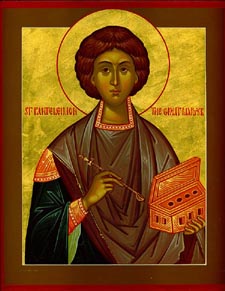 The Great Martyr and Healer Panteleimon was born in the city of Nicomedia into the family of the illustrious pagan Eustorgius, and he was named Pantoleon. His mother Saint Euboula (March 30) was a Christian. She wanted to raise her son in the Christian Faith, but she died when the future martyr was just a young child. His father sent Pantoleon to a pagan school, after which the young man studied medicine at Nicomedia under the renowned physician Euphrosynus. Pantoleon came to the attention of the emperor Maximian (284-305), who wished to appoint him as royal physician when he finished his schooling.
The Great Martyr and Healer Panteleimon was born in the city of Nicomedia into the family of the illustrious pagan Eustorgius, and he was named Pantoleon. His mother Saint Euboula (March 30) was a Christian. She wanted to raise her son in the Christian Faith, but she died when the future martyr was just a young child. His father sent Pantoleon to a pagan school, after which the young man studied medicine at Nicomedia under the renowned physician Euphrosynus. Pantoleon came to the attention of the emperor Maximian (284-305), who wished to appoint him as royal physician when he finished his schooling.
The hieromartyrs Hermolaus, Hermippus and Hermocrates, survivors of the massacre of 20,000 Christians in 303 (December 28), were living secretly in Nicomedia at that time. Saint Hermolaus saw Pantoleon time and again when he came to the house where they were hiding. Once, the priest invited the youth to the house and spoke about the Christian Faith. After this Pantoleon visited Saint Hermolaus every day.
Martyr Parasceva of Rome
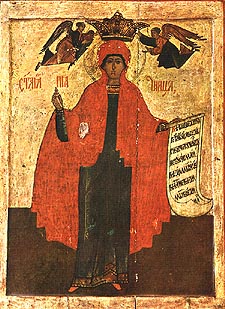 Holy Virgin Martyr Paraskeva of Rome was the only daughter of Christian parents, Agathon and Politia, and from her early years she dedicated herself to God. She spent much of her time in prayer and the study of the Holy Scriptures. After the death of her parents Saint Paraskeva distributed all of her inheritance to the poor, and consecrated her virginity to Christ. Emulating the holy Apostles, she began to preach to the pagans about Christ, converting many to Christianity.
Holy Virgin Martyr Paraskeva of Rome was the only daughter of Christian parents, Agathon and Politia, and from her early years she dedicated herself to God. She spent much of her time in prayer and the study of the Holy Scriptures. After the death of her parents Saint Paraskeva distributed all of her inheritance to the poor, and consecrated her virginity to Christ. Emulating the holy Apostles, she began to preach to the pagans about Christ, converting many to Christianity.
She was arrested during the reign of Antoninus Pius (138-161) because she refused to worship the idols. She was brought to trial and fearlessly confessed herself a Christian. Neither enticements of honors and material possessions, nor threats of torture and death shook the firmness of the saint nor turned her from Christ. She was given over to beastly tortures. They put a red-hot helmet on her head and threw her in a cauldron filled with boiling oil and pitch. By the power of God the holy martyr remained unharmed. When the emperor peered into the cauldron, Saint Paraskeva threw a drop of the hot liquid in his face, and he was burned. The emperor began to ask her for help, and the holy martyr healed him. After this the emperor set her free.
Archimandrite Jovan (Radosavlević): Several Episodes from the Life of Patriarch Pavle
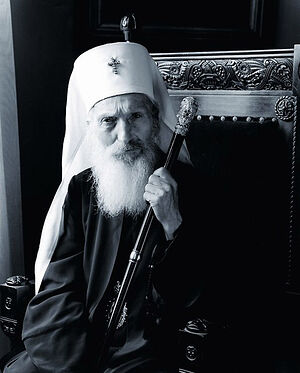 Knowing about the veneration and love that the Orthodox faithful around the world have for Patriarch Pavle of Serbia, we invite readers to get acquainted with several recollections of this bright man, written by Archimandrite Jovan (Radosavlević), a contemporary, companion, and co-struggler with the late Patriarch. In his youth, during the war, he met Gojko Stojčević—the name of the future Patriarch—at a Serbian monastery. From that time, they were linked by a strong friendship, which Fr. Jovan remembers fondly and gratefully. The episodes from the life of Patriarch Pavle that he here acquaints readers with are sad and dangerous, joyful and humorous, showing calmness, trust, and love for Christ and the people, who helped not only the Serbian ascetic and his contemporaries, but also their descendants. Here are a few such episodes.
Knowing about the veneration and love that the Orthodox faithful around the world have for Patriarch Pavle of Serbia, we invite readers to get acquainted with several recollections of this bright man, written by Archimandrite Jovan (Radosavlević), a contemporary, companion, and co-struggler with the late Patriarch. In his youth, during the war, he met Gojko Stojčević—the name of the future Patriarch—at a Serbian monastery. From that time, they were linked by a strong friendship, which Fr. Jovan remembers fondly and gratefully. The episodes from the life of Patriarch Pavle that he here acquaints readers with are sad and dangerous, joyful and humorous, showing calmness, trust, and love for Christ and the people, who helped not only the Serbian ascetic and his contemporaries, but also their descendants. Here are a few such episodes.
Patriarch Pavle : On Guilelessness and Wisdom
 To be truly human in this world is really the same as being a sheep among wolves, for the whole world lieth in wickedness (1 Jn. 5:19). I again say to you, remember: A sheep among wolves is subject to danger from two sides. Firstly, the wolves can tear him apart. But this is in the hands of God. And secondly, a sheep can decide that when you’re surrounded by wolves there is no other way to survive than to become like a wolf, sharpen your teeth, learn how to howl, exchange your hooves for claws, and so from a sheep turn into a wolf. Christ did not send us for this, but so that by our faith and life in the faith we might attract wolves into becoming Christ’s sheep, if they want to.
To be truly human in this world is really the same as being a sheep among wolves, for the whole world lieth in wickedness (1 Jn. 5:19). I again say to you, remember: A sheep among wolves is subject to danger from two sides. Firstly, the wolves can tear him apart. But this is in the hands of God. And secondly, a sheep can decide that when you’re surrounded by wolves there is no other way to survive than to become like a wolf, sharpen your teeth, learn how to howl, exchange your hooves for claws, and so from a sheep turn into a wolf. Christ did not send us for this, but so that by our faith and life in the faith we might attract wolves into becoming Christ’s sheep, if they want to.
Holy Archangel Gabriel
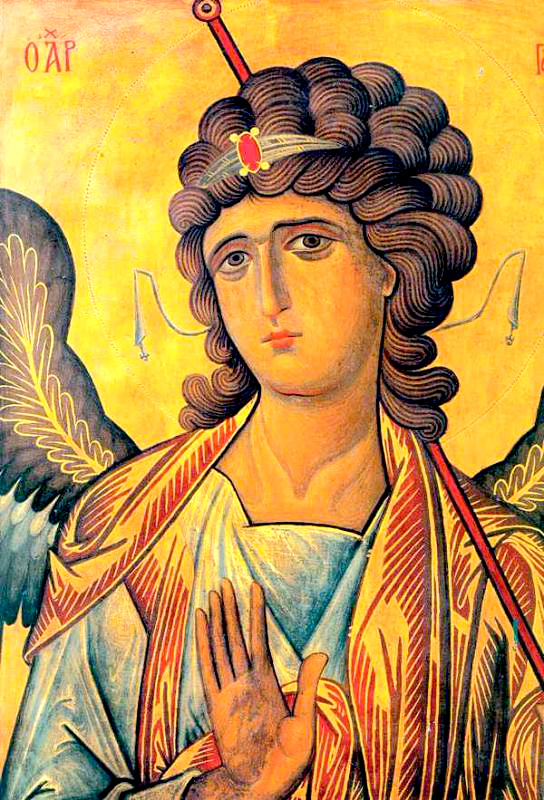 Synaxis of the Holy Archangel Gabriel: The Archangel Gabriel was chosen by the Lord to announce to the Virgin Mary about the Incarnation of the Son of God from Her, to the great rejoicing of all mankind. Therefore, on the day after the Feast of the Annunciation, the day on which the All-Pure Virgin is glorified, we give thanks to the Lord and we venerate His messenger Gabriel, who contributed to the mystery of our salvation.
Synaxis of the Holy Archangel Gabriel: The Archangel Gabriel was chosen by the Lord to announce to the Virgin Mary about the Incarnation of the Son of God from Her, to the great rejoicing of all mankind. Therefore, on the day after the Feast of the Annunciation, the day on which the All-Pure Virgin is glorified, we give thanks to the Lord and we venerate His messenger Gabriel, who contributed to the mystery of our salvation.
Gabriel, the holy Archistrategos (Leader of the Heavenly Hosts), is a faithful servant of the Almighty God. He announced the future Incarnation of the Son of God to those of the Old Testament; he inspired the Prophet Moses to write the Pentateuch (first five books of the Old Testament), he announced the coming tribulations of the Chosen People to the Prophet Daniel (Dan. 8:16, 9:21-24); he appeared to Saint Anna (July 25) with the news that she would give birth to the Virgin Mary.
Icon of the Mother of God “Of the Three Hands”
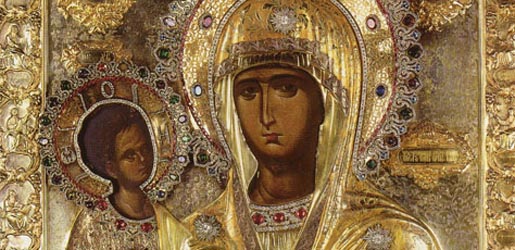 The Icon of the Mother of God, “Of the Three Hands”: In the eighth century during the time of the Iconoclasts, Saint John of Damascus (December 4) was zealous in his veneration of holy icons. Because of this, he was slandered by the emperor and iconoclast Leo III the Isaurian (717-740), who informed the Damascus caliph that Saint John was committing treasonous acts against him. The caliph gave orders to cut off the hand of the monk and take it to the marketplace. Towards evening Saint John, having asked the caliph for the cut-off hand, put it to its joint and fell to the ground before the icon of the Mother of God. The monk begged Our Lady to heal the hand, which had written in defense of Orthodoxy. After long prayer he fell asleep and saw in a dream that the All-Pure Mother of God had turned to him promising him quick healing.
The Icon of the Mother of God, “Of the Three Hands”: In the eighth century during the time of the Iconoclasts, Saint John of Damascus (December 4) was zealous in his veneration of holy icons. Because of this, he was slandered by the emperor and iconoclast Leo III the Isaurian (717-740), who informed the Damascus caliph that Saint John was committing treasonous acts against him. The caliph gave orders to cut off the hand of the monk and take it to the marketplace. Towards evening Saint John, having asked the caliph for the cut-off hand, put it to its joint and fell to the ground before the icon of the Mother of God. The monk begged Our Lady to heal the hand, which had written in defense of Orthodoxy. After long prayer he fell asleep and saw in a dream that the All-Pure Mother of God had turned to him promising him quick healing.

